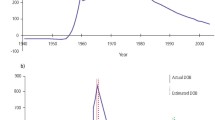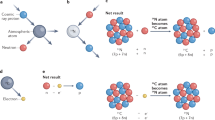A legacy from above-ground testing provides a precise indicator of the year in which a person was born.
Abstract
Establishing the age at death of individuals is an important step in their identification and can be done with high precision up to adolescence by analysis of dentition, but it is more difficult in adults. Here we show that the amount of radiocarbon present in tooth enamel as a result of nuclear bomb testing during 1955–63 is a remarkably accurate indicator of when a person was born. Age is determined to within 1.6 years, whereas the commonly used morphological evaluation of skeletal remains and tooth wear is sensitive to within 5–10 years in adults.
This is a preview of subscription content, access via your institution
Access options
Subscribe to this journal
Receive 51 print issues and online access
$199.00 per year
only $3.90 per issue
Buy this article
- Purchase on Springer Link
- Instant access to full article PDF
Prices may be subject to local taxes which are calculated during checkout

Similar content being viewed by others
References
De Vries, H. Science 128, 250–251 (1958).
Nydal, R. & Lovseth, K. Nature 206, 1029–1031 (1965).
Levin, I. & Kromer, B. Radiocarbon 46, 1261–1272 (2004).
Libby, W. F., Berger, R., Mead, J. F., Alexander, G. V. & Ross, J. F. Science 146, 1170–1172 (1964).
Harkness, D. D. Nature 240, 302–303 (1972).
Spalding, K. L., Bhardwaj, R. D., Buchholz, B. A., Druid, H. & Frisén, J. Cell 122, 133–143 (2005).
Nolla, C. M. J. Dent. Child. 27, 254–266 (1960).
Bolanos, M. V., Manrique, M. C., Bolanos, M. J. & Briones, M. T. Foren. Sci. Int. 110, 97–106 (2000).
Ritz-Timme, S. et al. Int. J. Legal Med. 113, 129–136 (2000).
Otlet, R. L., Walker, A. J., Fulker, M. J. & Collins, C. J. Envir. Radioact. 34, 91–101 (1997).
Author information
Authors and Affiliations
Corresponding author
Ethics declarations
Competing interests
We have filed a patent application for the described method. We do not have any link to any commercial entity regarding this. However, a patent, if granted, may have value in the future that could be influenced by this publication.
Supplementary information
Rights and permissions
About this article
Cite this article
Spalding, K., Buchholz, B., Bergman, LE. et al. Age written in teeth by nuclear tests. Nature 437, 333–334 (2005). https://doi.org/10.1038/437333a
Published:
Issue Date:
DOI: https://doi.org/10.1038/437333a
This article is cited by
-
Evolution of dental age estimation methods in adults over the years from occlusal wear to more sophisticated recent techniques
Egyptian Journal of Forensic Sciences (2021)
-
Radiocarbon dating
Nature Reviews Methods Primers (2021)
-
Molecular methods for age estimation
Rechtsmedizin (2021)
-
Decadal carbon decomposition dynamics in three peatlands in Northern Minnesota
Biogeochemistry (2019)
-
Fine-root growth in a forested bog is seasonally dynamic, but shallowly distributed in nutrient-poor peat
Plant and Soil (2018)
Comments
By submitting a comment you agree to abide by our Terms and Community Guidelines. If you find something abusive or that does not comply with our terms or guidelines please flag it as inappropriate.



